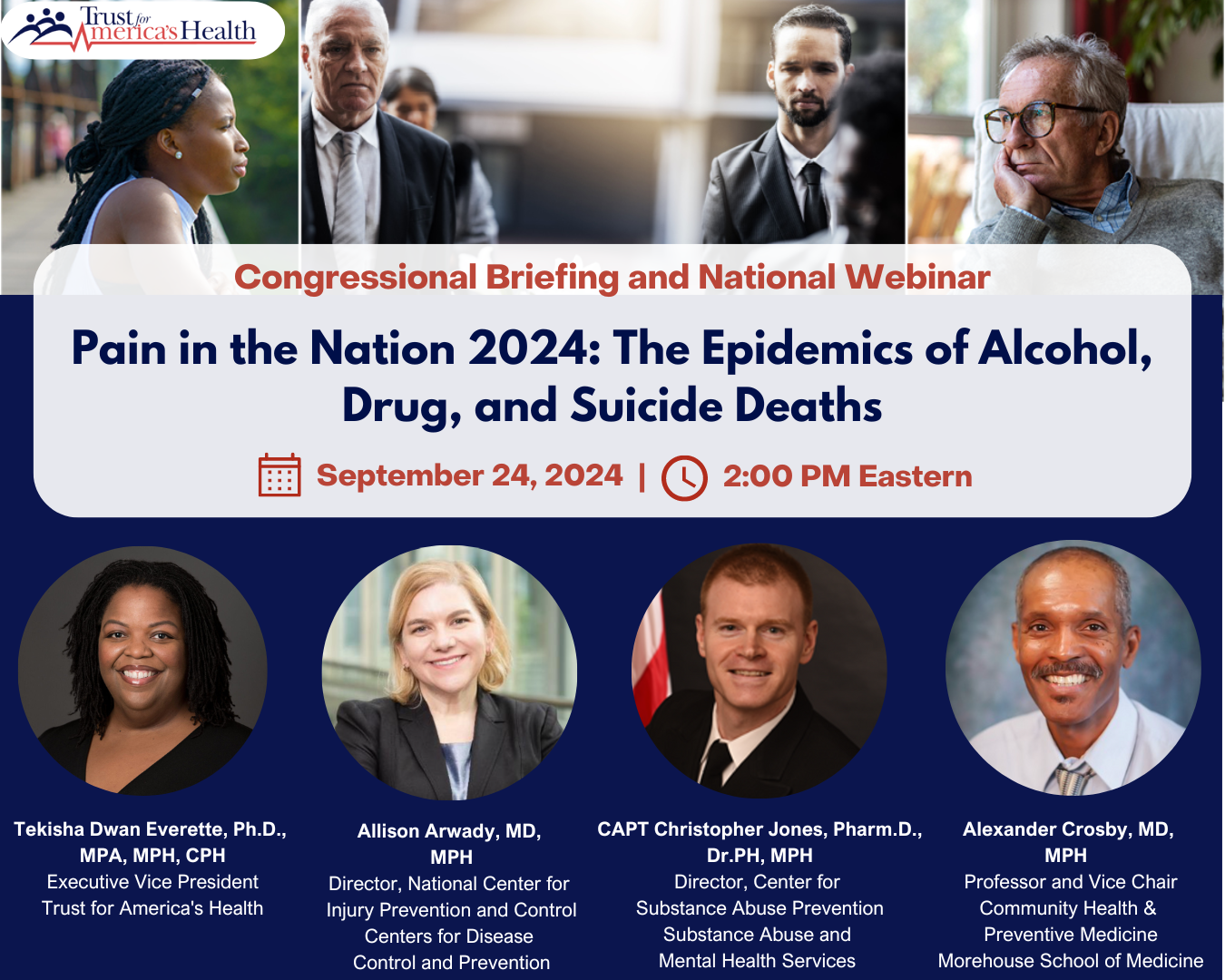Data Show First Improvement in Combined Substance Misuse and Suicide Mortality Rate in Five Years but Multidecade Trends Remain Alarmingly High
(Washington, DC – July 31, 2024) – A decrease in the alcohol-induced mortality rate led to a slightly lower combined rate of all U.S. deaths due to alcohol, drugs, and suicide in 2022, but the long-term trend of such deaths is still alarmingly high, according to a report released today by Trust for America’s Health.
The report, Pain in the Nation 2024: the Epidemics of Alcohol, Drug, and Suicide Deaths, includes data showing that between 2002 and 2022, combined rate of deaths due to alcohol, drugs, and suicide have increased by 142 percent from 74,003 deaths in 2002 to 207,827 deaths in 2022.
For 2022, the alcohol-induced mortality rate decreased by six percent to 13.5 deaths per 100,000 people, the first decrease in the rate after more than a decade of increases, but death rates for drug overdose and suicide remained unchanged.
Rates and trends for deaths due to substance misuse and suicide vary across population groups and states and regions of the country. While all population groups have experienced increases in substance misuse and suicide deaths over the last two decades, American Indian and Alaska Native people, Black people, and white people have higher than average combined rates for alcohol, drug, and suicide deaths.
In 2022, states with the highest rates of deaths due to alcohol, drugs, and suicide were New Mexico (124.3 deaths per 100,000 people), West Virginia (115.7 deaths per 100,000 people), and Alaska (104.1 deaths per 100,000 people).
Substance use and drug overdose
The overall age-adjusted drug overdose mortality rate was virtually unchanged from 2021 to 2022 (32.4 deaths per 100,000 people and 32.6 deaths per 100,000 respectively), but despite the flat trend, 107,941 people died in the U.S. due to a drug overdose in 2022.
According to data collected by the U.S. Substance Abuse and Mental Health Services Administration, in 2022 approximately 70 million people in the U.S. aged 12 and older – about one-quarter of the adolescent and adult population – reported using one or more illegal drugs and just under 10 percent of people aged 12 and over in the U.S. had a drug use disorder.
Drug overdose rates were highest among American Indian/Alaska Native people at 65.2 deaths per 100,000 people, adults ages 35 to 54 (59.4 deaths per 100,000), Black people (47.5 deaths per 100,000), and males (45.6 deaths per 100,000).
Alcohol Misuse
Despite the decrease in alcohol-induced deaths in 2022, 51,191 people in the U.S. died from alcohol-induced causes during the year. Alcohol-induced deaths were highest among American Indian and Alaska Native people (78.4 deaths per 100,000 people) and adults ages 55 to 74 (34.9 deaths per 100,000 people).
Suicide Deaths
In 2022, 49,476 people in the U.S. died from suicide. Overall mortality due to suicide was virtually unchanged between 2021 and 2022: 14.1 deaths per 100,000 people and 14.2 deaths per 100,000, respectively.
The highest rate of suicide was among American Indian/Alaska Native people (27.1 deaths per 100,000 people), males (23 deaths per 100,000), older adults (21 deaths per 100,000), and people living in rural areas (20.5 deaths per 100,000). Suicide mortality between age groups moved in different directions with suicide deaths among young people (ages 0-17 and 18 – 34) decreasing while increasing for all older age groups.
“While the stabilization in the combined rate of alcohol, drug, and suicide deaths in 2022 is promising news, it is overshadowed by decades of tragically increasing numbers of such deaths and spotlights the need to continue to apply evidence-based solutions in order to save lives,” said J. Nadine Gracia, M.D., MSCE, President and CEO, Trust for America’s Health. “We have strategies that we know work, including early prevention and harm reduction strategies, creating safe and supportive schools, ensuring access to mental and behavioral healthcare, and creating community conditions that support children and families. We need to invest in these policies and programs.”
Report Recommendations
The report includes recommendations for steps that federal, state, local government and other stakeholders should take to address the substance misuse and suicide crisis, including:
Invest in prevention and community conditions that promote health, including programs to reduce adverse childhood experiences and those that support families and offer trauma-informed and culturally appropriate services for youth.
Reduce overdose risk and access to lethal means of suicide through harm reduction programs including syringe services programs, access to overdose prevention medications like naloxone, and promoting safe storage of all firearms.
Strengthen the mental health and substance use prevention system by continuing to build a continuum of crisis intervention programs, ensuring access to mental health and substance use services, and growing the mental health workforce while increasing its diversity and offering more culturally and linguistically responsive services.
Trust for America’s Health is a nonprofit, nonpartisan public health policy, research, and advocacy organization that promotes optimal health for every person and community and makes the prevention of illness and injury a national priority.



